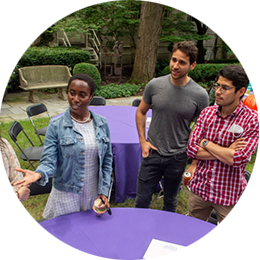News
Northwestern Law Professor's Research Reveals How Jurors Really Behave
January 04, 2006
The Seventh Amendment's right of trial by jury has been fraught with controversy ever since its adoption during the early years of the republic. Today research by Shari Seidman Diamond, Howard J. Trienens Professor of Law at Northwestern Law and senior fellow at the American Bar Foundation, tempers all the heated rhetoric about jury decision making by showing how jurors actually behave.
Armed with a law degree from University of Chicago, a PhD in social psychology from Northwestern, and unprecedented access to actual jury decision making, Diamond has widely recognized expertise on a subject that continues to fascinate us. In recent years, she has been called upon by The New York Times, for example, to comment on how the then two-year-old Tyco trial and its jury would be affected by the apparently bizarre behavior of one of its jurors. Another time she weighed in on how jury instructions may have hampered decision making by the Michael Jackson jury.
Despite popular notions, Diamond's research has taught her that jurors, when given proper instructions and respect for their intelligence, are relatively good decision makers.
"The emphasis should be on giving jurors enough clear information about what they need to solve problems," she says. "But the legal system often treats the jury as a radioactive isotope, a valuable but unstable element whose power is so great and whose behavior is so unpredictable that the only reasonable response is an elaborate system of control."
Diamond's recent work on the American Jury Project, an ABA task force charged with designing standards for juries and jury trials, was greatly informed by her research, some of which came out of the one-of-a-kind Arizona Project.
One of her Arizona project studies, for example, concluded that judges should permit jurors to submit questions to witnesses during the course of a trial. Judges often don't exercise that option, because they worry that when jurors are told that they can't answer a particular question, jurors will become upset, jump to wrong conclusions or somehow skew their decision making.
"But our research shows that when judges tell jurors that they can't answer a question, jurors understand, for example, that the rules of evidence and other legalities might preclude certain questions and easily move on," Diamond says. "The need to leave some juror questions unanswered offers no justification for missing the opportunity to assist jurors in reaching well-grounded decisions."
Accordingly, the recently revised ABA jury standards that she worked on recommend that judges allow jurors to ask questions, suggesting that judges be as forthright as possible about why certain questions will not be allowed.
Through the Arizona Jury Project, Diamond and her colleagues received unprecedented access to what goes on behind the closed doors of jury rooms.
Because of the adoption of Rule of Civil Procedure 39 (f), a controversial innovation in the civil court system, jurors in Arizona are allowed to discuss cases during trial breaks rather than only in final deliberations. Interested in how the rule would impact jury behavior, Arizona lawmakers allowed unobtrusive video cameras in jury rooms, giving researchers a highly valued peek at how jurors deal with instructions and evidence.
Researchers usually rely on simulated trials to study jury decision making. Through the Arizona project, they observed real jurors to analyze various aspects of how juries behave and, thanks to the Arizona innovation, have access to their thinking throughout the trial. Diamond, with her colleague Professor Mary Rose at the University of Texas, continues to publish studies from her analyses of the Arizona project data collected from the videotapes of 50 civil cases as well as post-trial questionnaires from jurors.
In the first part of the project, Diamond and Professor Neil Vidmar of Duke University addressed arguments against allowing jurors to discuss a case throughout the trial, as the Arizona reform allowed, rather than only in the final deliberations. According to one argument, such trial-long discussions of the cases would lead to premature verdicts.
"Some individual jurors did offer positions on verdicts before official final deliberations began," Diamond says. "But what they said did not necessarily match their final verdicts, and no jury arrived at a group verdict before final deliberations."
Most striking, jurors corrected misunderstandings during those trial-long discussions and solidified some of the memories that in a complex case are important for them to understand.
"In other words, much of what they did was exactly what one would hope they would do," Diamond says.
Another of Diamond's studies showed that jurors often talk about insurance when they are forbidden to do so. In most cases, insurance is legally irrelevant and nondisclosure regarding insurance is viewed as crucial so that jurors will not be tempted to find for the plaintiff just because an insurance company has the wherewithal to pay for injuries.
But, Diamond found, jurors' focus on insurance did not reflect the common wisdom that jurors are eager to find a reason to raid the deep pockets of insurance companies. Instead, jurors were often concerned about plaintiffs' prior recoveries for medical expenses. Thus, the research shows, juror speculation about insurance may sometimes reduce—rather than increase—awards.
Once again, Diamond found that poor communication with jurors is the main problem.
"To the extent that jurors enter the courtroom unsure about the role that insurance should play and that courts decline to address the issue, the ground is laid for juries to rely on their own assumptions on how to treat the issue of insurance," she says.
The argument for non-unanimous verdicts in civil cases, allowed in many states, is the focus of another of Diamond's studies.
"The Arizona deliberations reveal that some of the claims made in favor of dispensing with unanimity are unfounded," Diamond wrote in "Revisiting the Unanimity Requirement: the Behavior of the Non-Unanimous Civil Jury" (Northwestern University Law Review, vol. 100, no. 1, 2005).
Advocates argue that the non-unanimous verdict protects the jury from the obstinacy of the erratic or otherwise unreasonable holdout juror. Critics of the non-unanimous decision rule claim that it weakens the ability of jurors holding plausible minority viewpoints to be heard, undermines robust debate and threatens the legitimacy of jury verdicts.
"The image of eccentric holdout jurors outvoted by sensible majorities in non-unanimous trials receives no support," Diamond says. "Instead the deliberations demonstrate that thoughtful minorities are sometimes marginalized when the majority has the power to ignore them in reaching a verdict."
The 2005 ABA Principles for Juries and Jury Trials reflects an effort to encourage states that currently permit non-unanimous verdicts to revisit those decisions.
Another of Diamond's studies showed that, contrary to popular commentary, jurors do pay attention to the law, frequently referring to judicial instructions. But because of the way instructions are written, even in Arizona, jurors get very little assistance.
"On occasion jurors do import their understanding of the law from everyday life, which is sometimes right and sometimes wrong, pointing out the need for better jury instructions," Diamond says.
Diamond welcomed the opportunity to draw upon her research on the jury for her American Jury Project work. In helping to draft the ABA's jury standards for jury trials, she called upon research that keeps bringing home the importance of giving jurors better instructions and tools to communicate with each other and key players at the trial.
"Juries make mistakes, and they display evidence of bias, but there is no convincing evidence that another decision maker would do better," Diamond and Rose wrote in their recent review of the jury in the Annual Review of Law and Social Science (vol. 1: 255-284, December 2005).
"Nonetheless, those interested in optimizing modern jury trials would do well to reconsider Judge Jerome Franks' lament [in 1949] that ‘even 12 experienced judges, deliberating together, would probably not function well under the conditions we impose on the 12 inexperienced laymen.'"
- Categories:






